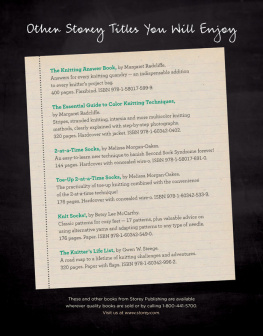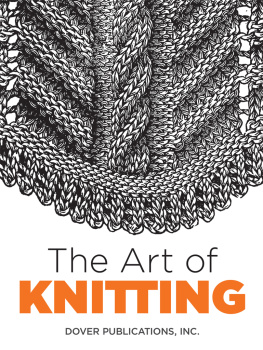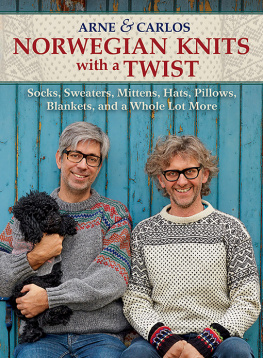CIRCULAR KNITTING WORKSHOP
Essential Techniques to Master Knitting in the Round
Margaret Radcliffe
photography by
JOHN POLAK

The mission of Storey Publishing is to serve our customers by
publishing practical information that encourages
personal independence in harmony with the environment.
Edited by Gwen Steege
Art direction and book design by Mary Winkelman Velgos
Cover and interior photography by John Polak Photography, except for paper textures pages by Marek Ludzen/iStockphoto.com
Pattern diagrams and how-to illustrations by Leslie Anne Charles
Knitting technique illustrations by Alison Kolesar
Indexed by Nancy D. Wood
Technical editing by Charlotte Quiggle
2012 by Margaret Radcliffe
All rights reserved. No part of this book may be reproduced without written permission from the publisher except by a reviewer who may quote brief passages or reproduce illustrations in a review with appropriate credits; nor may any part of this book be reproduced, stored in a retrieval system, or transmitted in any form or by any means electronic, mechanical, photocopying, recording, or other without written permission from the publisher
The information in this book is true and complete to the best of our knowledge. All recommendations are made without guarantee on the part of the author or Storey Publishing. The author and publisher disclaim any liability in connection with the use of this information.
Storey books are available for special premium and promotional uses and for customized editions. For further information, please call 1-800-793-9396.
Storey Publishing
210 MASS MoCA Way
North Adams, MA 01247
www.storey.com
Printed in the United States by Versa Press
10 9 8 7 6 5 4 3 2 1
LIBRARY OF CONGRESS CATALOGING-IN- PUBLICATION DATA
Radcliffe, Margaret (Margaret K. K.)
Circular knitting workshop / by Margaret Radcliffe.
p. cm.
Includes index.
ISBN 978-1-60342-999-3 (pbk.)
1. Knitting. 2. Knitting Patterns. I. Radcliffe, Margaret. II. Title.
TT825.R25 2012
746.432 dc23
2011025033
CONTENTS
To David, who makes it all Possible

WHY KNIT CIRCULARLY?
If you already knit in the round, you probably already know the answer to this question. Circular knitting lets you work on the right side of the fabric all the time. Its especially suited to some knitting techniques, like stranded color work. There are few or no seams to be joined. Its convenient to carry around circular needles dont poke the passenger next to you in the plane or on the bus and you dont need to worry about dropping one of a set of needles or a needle poking through your bag and taking off on an unsupervised excursion of its own. Many knitters find that circular knitting is easier on their hands or arms, because they hold the needles and support the work-in-progress differently than when knitting flat. Some knitters love the meditative flow of knitting in the round it goes on and on without any interruptions for turning or switching hands.
I myself am a firm believer in what I call knitterly solutions. A knitterly solution is an approach to a project that makes it easier to knit, while producing better results than working it conventionally or as the instructions dictate. Knitterly solutions are straightforward and uncomplicated, making work on a project more comfortable, leaving the knitter more relaxed, and resulting in a more enjoyable experience and better results all around. In other words, knitterly solutions are based on what knitting naturally does well.
Once youre familiar with the staggering range of circular knittings possibilities, youll see that some projects just beg to be made in the round because its so much more efficient and effective than flat knitting. To take just one example, sewing together a garment made entirely of lace so that all the seams look flawless can be an incredibly frustrating and time-consuming process and is likely to end in failure because its nearly impossible to sew seams neatly in a lacey knitted fabric. But work the same project circularly, eliminating the seams, and not only do you end up with a garment that looks better, you dont have to spend the additional time sewing up.
Why This Book?
Sometimes its easiest to define a thing by what it is not. This is not a book of patterns for circular projects. So what is in this book? First of all, theres a wideranging discussion of circular knitting techniques, with enough detail so that those unfamiliar with circular knitting will be able to get started just using this book and so that those already enamored of knitting in the round will discover new approaches and applications of techniques. Second, this book is packed with workshop projects the kinds of projects I find most useful to teach circular garment and accessory construction in my knitting classes. The projects are small, with instructions for just one size, and designed to teach as much as possible with a minimum expenditure of knitting effort. Youll find the technical discussions, including a chapter on converting flat patterns to circular, in -10.
This is a book to learn from and to refer back to. In writing it, I have tried to introduce you to the broadest possible range of uses for circular knitting, from the obvious (hats) to the obscure (sideways cuff-to-cuff sweaters) so that you thoroughly understand how to construct any shape circularly and can apply your knowledge to all your future knitting. When you knit from pattern instructions, it will be easier to stay oriented as you work the project, and youll better understand the designers choices, be able to question them, and know how to make adaptations. If you design for yourself, youll have an arsenal of techniques at your disposal, offering multiple approaches to every project.
Before You Start
Each of the workshop projects includes:
An introductory section. This highlights the specific techniques you will learn, lists the required needles, yarn and other supplies, and notes the gauge and finished measurements of the project pictured.
Instructions for making the project. These are for just one small size. Youll find cross references to techniques and details discussed elsewhere in the book. If I dont specifically tell you where to find additional information and explanations, check the appendix for details.
Variations on the project. A discussion in each project tells you how to make it any size you like and suggests possible variations, such as how to make a sock from the toe up rather than from the top down.
In the introduction to each project you will find the following note: Match the projects gauge if you want finished measurements to match pattern instructions. This is because, for purposes of learning the techniques, it doesnt matter if you use the same thickness of yarn, use the suggested needle size, or work at the suggested gauge; however (and this is a big however), you need to understand that if you work with a different yarn weight or at a different gauge, your project will not be the same finished size or the fabric will not behave like the original. This is fine if you just want to learn the techniques. On the other hand, if you want to have a nice-looking, well-proportioned, satisfying finished product to be displayed proudly to your admiring public, you will need either to use the yarn weight specified and match the suggested gauge, or to exercise your own good judgment. When you substitute a different weight of yarn keep the following in mind:









